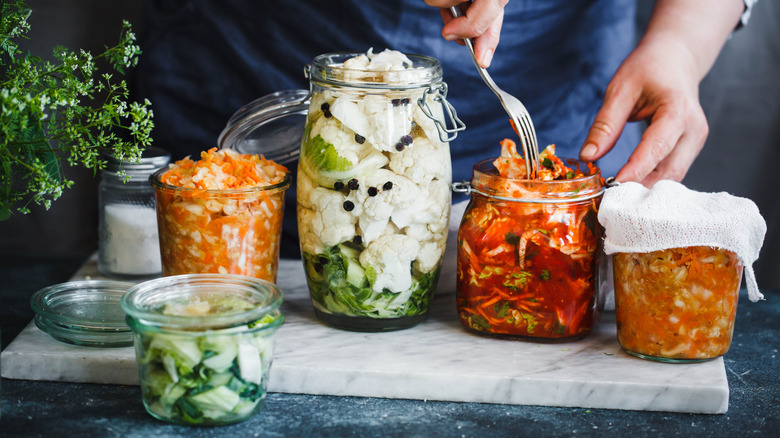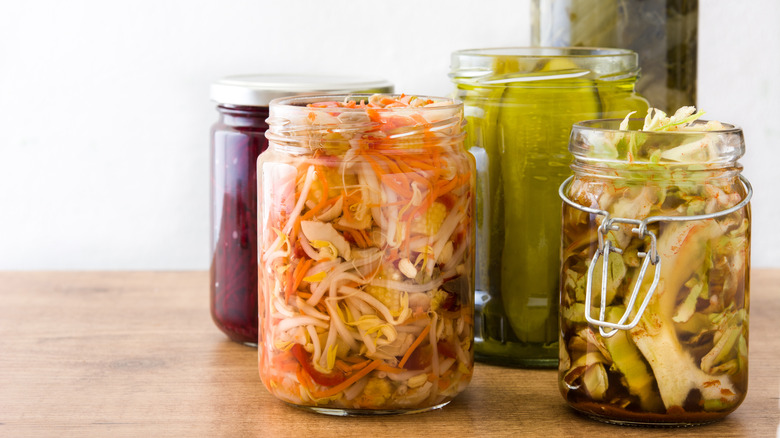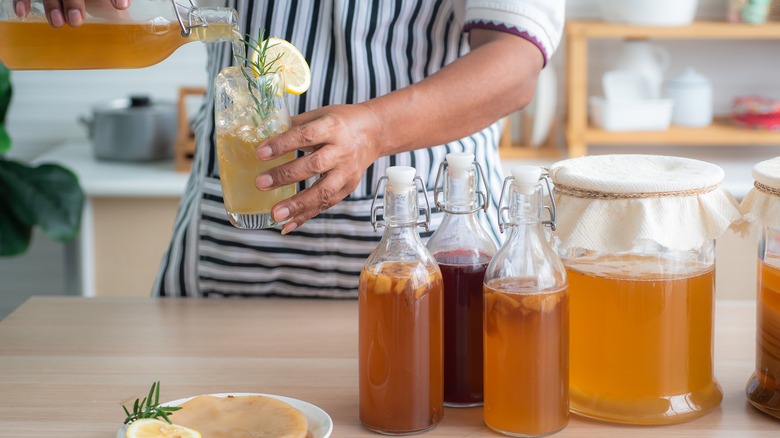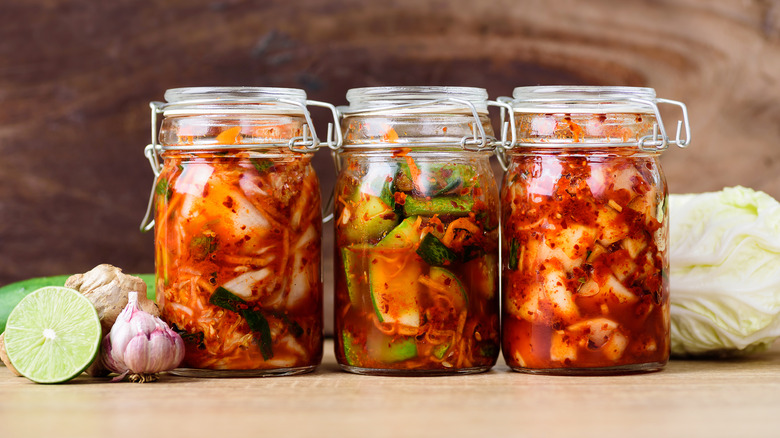Lacto-Fermented Foods Vs Fermented: Is There A Difference?
Fermented foods are seemingly everywhere these days. They're the darlings of nutritionists, home cooks, and even posh restaurants, which are making them the center of attention in fine dining. There's a long list of popular foods we eat that are the result of fermentation that you may not have even realized undergo the transformation caused by natural bacteria, such as coffee and chocolate. Like many cooking topics that are related to science, it helps to understand the terminology of fermentation that is sprinkled through recipes so you feel more confident taking on these delicious projects yourself.
When we talk about a large number of fermented foods as diverse as kosher pickles, kimchee, and yogurt, the term "lacto-fermentation" is often mentioned. The "lacto" prefix refers to lactobacillus bacteria that do the work of creating the sour taste in all these foods. That's slightly different from fermentation that doesn't involve that helpful bacteria — items like beer, wine, and kombucha undergo ethyl alcohol fermentation caused by yeast. Some foods, like sourdough bread, undergo both types of fermentation to develop their unique flavors.
What are lacto-fermented foods
Lactobacillus bacteria are all around us in the environment. They're responsible for the fermentation of many of the familiar sour foods we love. The microscopic bacteria break down sugars and starches and create tart lactic acid, along with fizzy carbon dioxide — that's why lacto-fermented foods have that sour flavor and bubbly liquid. Lacto-fermentation preserves foods so they can be eaten long after harvesting by crowding out the microbes that cause spoilage.
Many lacto-fermented foods start by soaking in a salty brine. Whether you're making a classic kimchi recipe or a colorful mixed cabbage and carrot sauerkraut, salting the vegetables is one of the first steps. After additional flavors are added, the vegetables are pressed below the level of the brine to keep mold at bay, and then the lactobacillus does all the hard work. After several days, little bubbles in the liquid announce the transformation of raw to fermented product.
Lacto-fermented dairy products like yogurt, cheese, and sour cream are an exception — for these liquid products, the lactobacillus is added in starter form. That could be as simple as using a bit of active culture yogurt or a powdered culture. The bacteria convert milk sugars to the same lactic acid found in other lacto-ferments.
Coffee and chocolate fermentation starts with those naturally occurring bacteria and yeasts on the fruit surrounding the coffee or cacao bean. The fruit is allowed to ferment naturally, which changes the flavor of the bean, bringing out the flavors we love.
What are fermented foods
Fermentation is a broad catch-all term describing the breakdown of sugars and starches by bacteria and yeasts. Aside from lacto-fermentation by that strain of bacteria, there are other microorganisms, like yeasts and fungi, that convert sugars to alcohol. Wine and beer are products of this type of fermentation, along with hard liquors like vodka, whiskey, and gin. Natural fermentation can occur due to yeast from the environment living on grape skins or wheat berries causing alcohol production, or producers can add specific yeast to the grape juice or mash to start the process.
A few fermented foods make use of a complicated group of yeasts and bacteria that work together to transform foods into their new form. Kombucha is one of these, along with its milky cousin, kefir. Sourdough is another example of a food that's fermented by a combination of natural air-borne yeast, which gives off carbon dioxide to produce the airy bubbles in the dough, and local bacteria that add sour flavor to the loaf. Bakers control the sour tang of their bread by allowing the bacteria and yeast to ferment longer, in the same way that kimchi becomes more sour as it ages.
Another interesting family of fermented foods comes from the fungus koji, which transforms soybeans into miso and soy sauce. Crumbly tempeh and sticky natto also come from soybean products, fermented with a variety of bacteria that make the flavors and nutritional profiles unique but not sour.
Lacto-fermented foods have a sour tang
All lacto-fermented foods are technically a subcategory of overall fermentation — the natural transformation of foods by microorganisms. However, the specific type of bacteria, namely lactobacillus, creates the lactic acid that flavors the fermenting product. Depending on how long the food is left to ferment, it can be mildly sour (like a half-sour kosher pickle that barely packs a punch) all the way to slightly fizzy and mouth-puckering (like long-aged kimchi). Tart lactic acid was first discovered in dairy cultures, which is how it earned the name, but it is present any time lactobacillus is at work.
In the case of some lacto-fermented foods like chocolate and coffee, we don't end up consuming the actual fermented parts, but we benefit from the changes that happen as the bacteria act on the food. Other fermented food products that are transformed by fungi, bacteria, yeasts or a combination of all three have rich flavors thanks to the microorganisms at work, but they are not primarily sour.



